Parrot fish: varieties and secrets of content
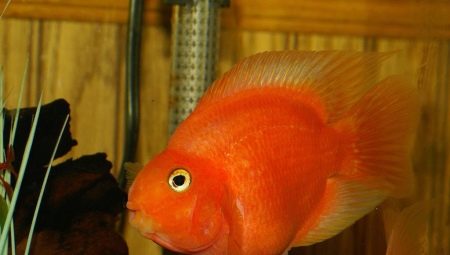
Parrot fish are well known and popular among aquarists. The demand for the species is due to its unpretentiousness to the conditions of detention and a bright appearance that can decorate any aquarium.
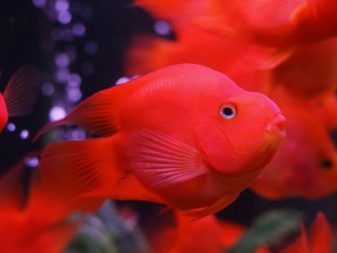

Description
The parrot fish, also known as the Japanese parrot or the red parrot (Latin Red Parrot Cichlid), is the result of selection experiments, does not occur in the natural environment. The species was obtained thanks to the labors of Taiwanese specialists in 1964 and immediately gained universal fame. The labiatum and severum, belonging to the cichlid family, and also distinguished by high decorativeness and good health, were used as parent individuals.
However, the full list of participants in breeding work on the breeding of the hybrid has not been announced - Asian breeders keep it secret. The involvement of the two listed species in this experiment was possible to establish only by indirect signs, such as external similarity and features of behavior.

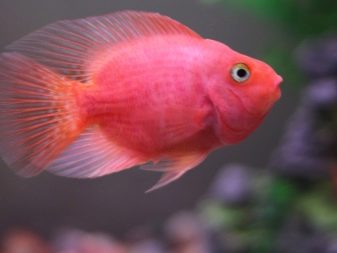
Like many young hybrids, parrotfish have some physical disabilities that naturally occurring species lack. As one of the abnormalities, a mouth that is too small, which does not allow them to eat normally, can be noted., nor to defend against more aggressive congeners. In addition, as a result of the transformation of genes, the spine of the parrot fish has been somewhat deformed, which is why the swim bladder also has some deviations in development.
These morphological defects negatively affect the swimming abilities of fish, making their stay in open water bodies impossible. In this regard, the parrot fish is exclusively a room fish and is able to live only in the comfortable conditions of the aquarium.
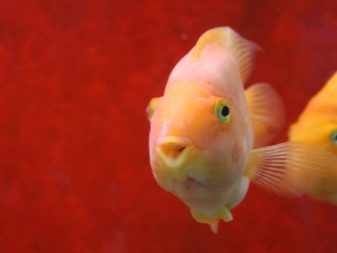

The parrot fish looks unusually beautiful. The body has an interesting barrel-shaped shape, the caudal fin is rather short, and the fish themselves grow up to 25-30 cm. There is also a tailless version - a heart-shaped parrot, which looks very graceful and non-standard. It stands out among the rest of the inhabitants of the aquarium with its interesting shape and bright colors.
Despite the beautiful color, the muzzle of the parrot fish is not very pretty. This is due to the humpback shape of the nose, which looks like a beak, and the canines protruding outward. Plus, parrotfish swim rather awkwardly, which also does not add grace and aesthetics to their appearance. However, a very beautiful coloring and interesting habits cause admiration and affection among aquarists, keeping the parrot fish on the high lines of the popularity rating.
Color should be discussed separately. The fact is that parrot fish are painted. Breeders in the course of their experiments use special dyes that are added to experimental specimens in food. As a result, parrot fish acquire unnaturally bright and beautiful colors, which they enchant others with.
However, having bought such a fish, the new owner is surprised to find that after a while the colors begin to fade, and then completely fade. Without the use of coloring doping, the fish completely loses its individuality and becomes the owner of an inconspicuous ordinary color.
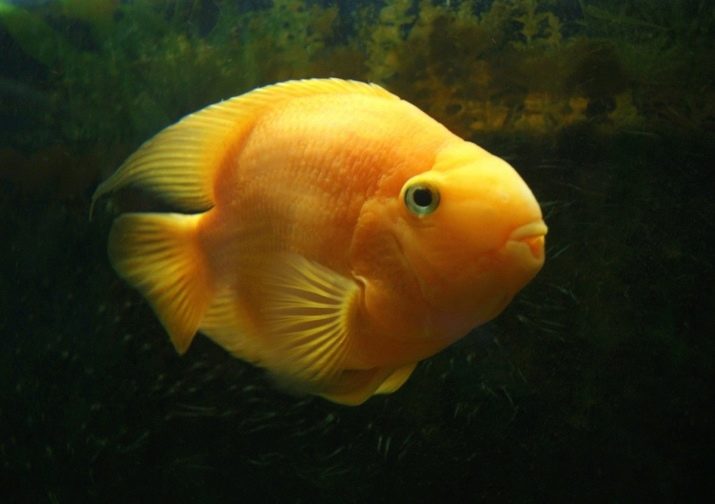
But the most unpleasant thing is not feeding the fish with dyes, but tattooing them. To do this, they are placed in a container with alkali, which dissolves natural mucus that protects the skin of the fish from damage and infection. Further, the unfortunate "parrots" are immersed in paint or tattooed on them.
The final stage of the execution is the placement of the fish in a special solution, which irritates the skin, thereby forcing it to intensively produce new mucus. During this wild procedure, a lot of parrotfish die, unable to withstand the bullying of Asian breeders. The surviving specimens, falling into normal conditions, live up to 10 years, are distinguished by good health and strong immunity.
but not all "parrots" are painted, most fish have a natural color... Among natural shades, red and orange colors predominate, yellow ones are a little less common. It should also be noted that among parrot fish, completely depigmented individuals are often found - albinos... They are characterized by poor health, low endurance and require more comfortable conditions.
Separately, mention should be made of the nature of the parrot fish. Unlike most American cichlids, they are quite friendly in nature and can be kept in communal aquariums. "Parrots" do not terrorize their neighbors, they are distinguished by high intelligence and quick wits. They are able to memorize in the face of their master and always unmistakably recognize him.
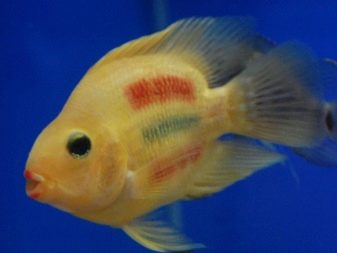

Overview of varieties
The classification of fish is made by body shape and color. There are more than 100 species of parrot fish in total, but only a few of them are most famous. The most common colors are yellow, gold, white, brilliant, marble, pearl and purple, as well as variegated varieties.
The most popular, however, is the red parrotfish. It is distinguished by its bright red color with orange gleams, a humped nose, similar to a beak, and protruding fangs. Adults grow up to 25 cm and are suitable for joint keeping with fish of other species.
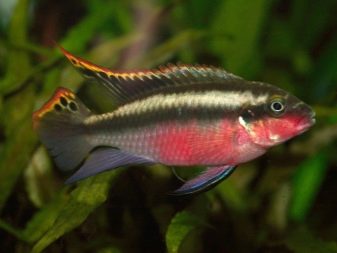
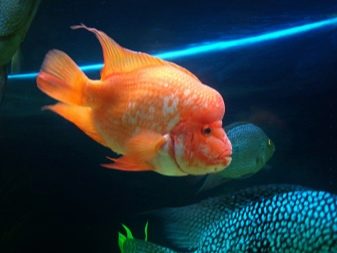
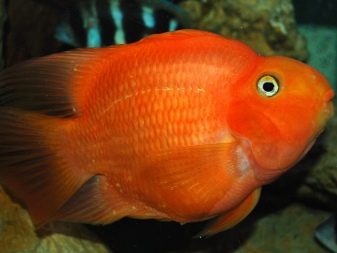

The second criterion for classification is the shape of the body and fins of the parrotfish. On this basis, the following hybrid varieties are distinguished:
- unicorn - a variety with a small seal on the head in the form of a horn;
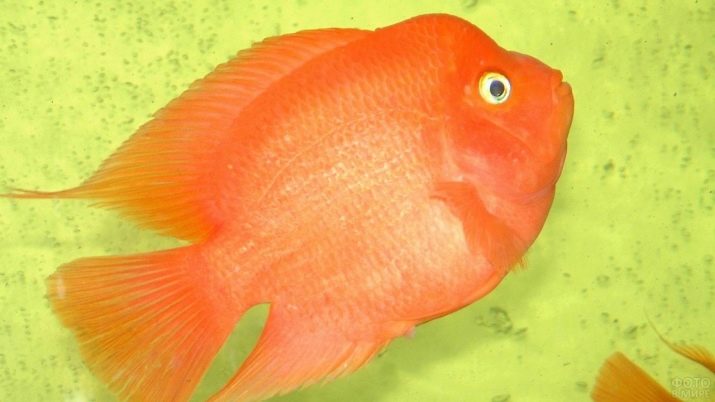
- a heart in love is a species that does not have a tail, which is why its body takes on somewhat unusual forms;
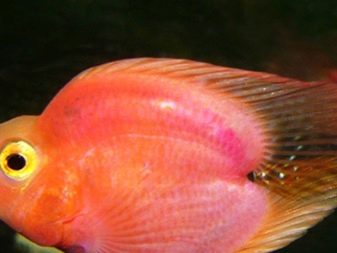
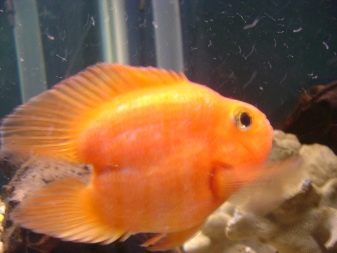
- red ingot - representatives of this variety have a body that resembles a disk, and they look very interesting;
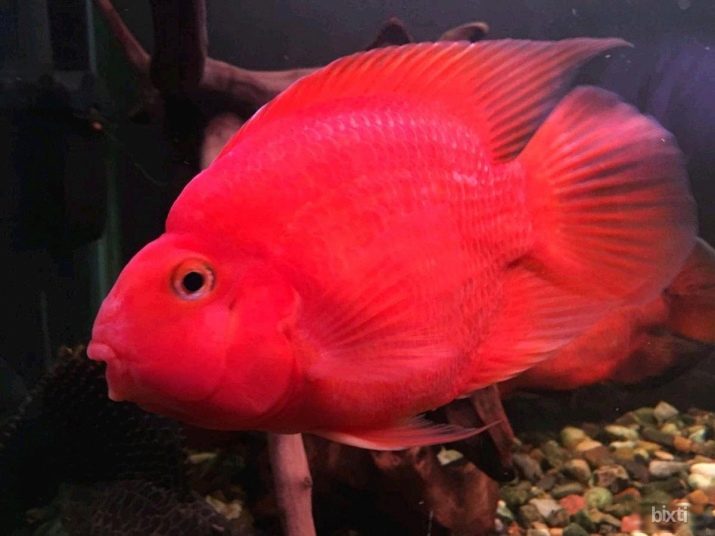
- red fortune is a species with very long fins and an impressive growth on the forehead.

- king kong - these fish are distinguished by their huge size and a large fatty lump on the frontal part of the head.
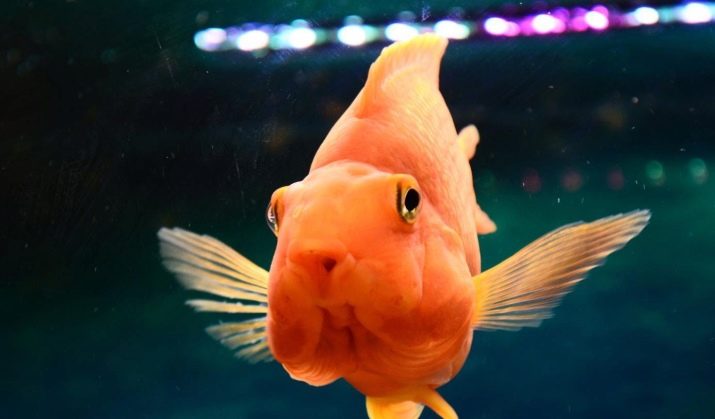
Compatibility with other fish
The parrotfish is one of the few American cichlid species that has no problem with its aquarium neighbors. They are non-aggressive and non-dirious, have no claims to other fish regarding the territory. "Parrots" are compatible with almost all aquarium fish and do not cause the owners of the problems that are typical for many species of South American cichlids.
Parrotfish get along well with catfish, barbs, black knives, astronotus, haracin and most types of cichlids. The exception is scalars - one of the smallest varieties of cichlids. This fish is constantly hiding in dense green algae, which "parrots" mercilessly eat. After the greens are eaten, they pay attention to miniature scalars, and strive to devour them.
Therefore, joint maintenance is allowed only in aquariums with a volume of more than 200 liters in the presence of all kinds of shelters and caves where a small scalar can hide. The same applies to all small fish, and if their size does not exceed 5 cm, then it is better not to settle them with "parrots".
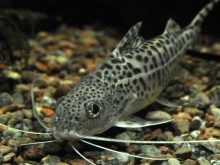
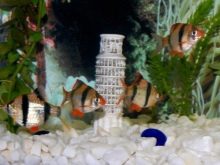
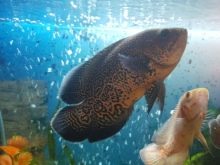
Features of the content
Parrotfish are unpretentious creatures, good for beginners and quite easy to care for. However, before purchasing them, you need to properly prepare the aquarium. To do this, it is advisable to take a container with a volume of at least 150 liters per pair of fish, fill it with disinfected soil and lay large roots, driftwood, large flat stones, ceramic pots and coconut shells on the bottom. These elements will serve as a hiding place for fish and a place for laying eggs.
It is recommended to use a mixture of river sand and small pebbles, taken in equal quantities, thoroughly mixed and calcined in the oven, as a soil. The layer thickness should be at least 6 cm, which is due to the tendency of "parrots" to dig the soil. In addition, the pebbles should be round and smooth, otherwise pets who love to swarm in the substrate can get hurt.
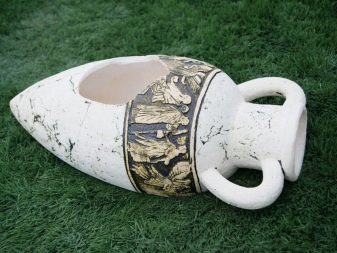
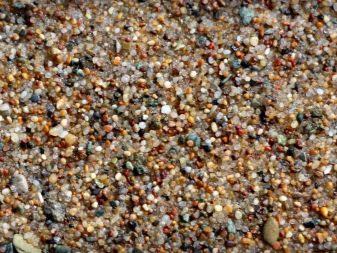
Then you need to purchase and install a powerful filter capable of distilling at least two volumes of the aquarium per hour, and a compressor that saturates the water with oxygen. Water renewal is performed weekly, while replacing from 20 to 30% of the total volume. The water temperature in the aquarium should be + 24-27 degrees Celsius, acidity - 7 units, and the hardness index is no more than 25 dGh.
And also we must not forget about the backlight. Parrotfish love moderate light, so if the aquarium is in a dark room, then it must be highlighted. Lamps with red light can be used as a lighting device, as they illuminate the fish scales very beautifully, making them even more spectacular.
For green spaces, it is best to plant them along the sides of the aquarium or in the background. This is due to the fact that during spawning, females pull out algae by the roots and lay eggs in the formed pits.
Therefore, it is wiser to use sturdy plants with strong roots, placing them along the side lines of the tank. To avoid jumping out of parrot fish from the water, the aquarium must be covered with a glass lid or net.

You can feed the "parrots" vegetable chopped food, live or frozen food, as well as dry granular formulations... You can diversify the diet with bloodworms, brine shrimp, shrimps and worms. As a top dressing, it is allowed to give live guppies and meat products. To prevent color loss, it is recommended to include foods rich in beta-carotene in the menu.
They feed parrot fish 2 times a day - in the morning and in the evening, while forming not too large portions. Food for them is subject to mandatory grinding, which is due to a small mouth and difficulties in eating. Once a week, it is necessary to arrange a fasting day, not giving the fish any food at all. This need is due to the tendency of parrot fish to overeat and rapid obesity.
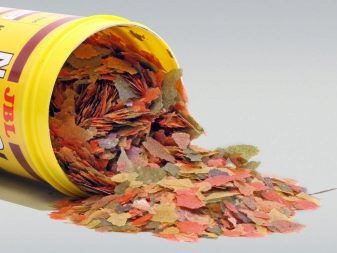
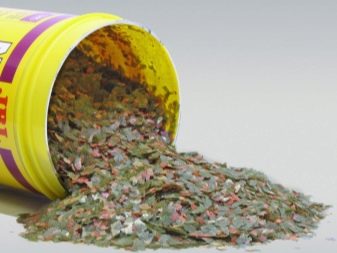
Considering the peculiarities of keeping parrot fish, one cannot but say about their diseases, which are often caused by poor conditions and an unbalanced diet. So, the appearance of black spots on the scales is explained by an ammonia burn or severe stress, which arose due to a destroyed shelter or a large overpopulation of the aquarium. In addition, parrotfish sometimes suffer from common fish diseases such as semolina and hexamitosis, however, in general, it is much stronger and healthier than all its ancestors.
Reproduction
Sexual dimorphism in this species is very weak, which is why at first glance it is very difficult to distinguish a young female from a male... This can be done only during spawning, when the ovipositor appears in females and the vas deferens in males. It is quite simple to distinguish between them: the ovipositor is quite wide, has the shape of a tube and is short in length, while the vas deferens is pointed and narrow.
And only with age (about one and a half years), noticeable external differences appear. Males acquire a brighter color, and their fins become pointed. In addition, at this age, they are already noticeably larger than females, which does not allow mistakes in sex determination.
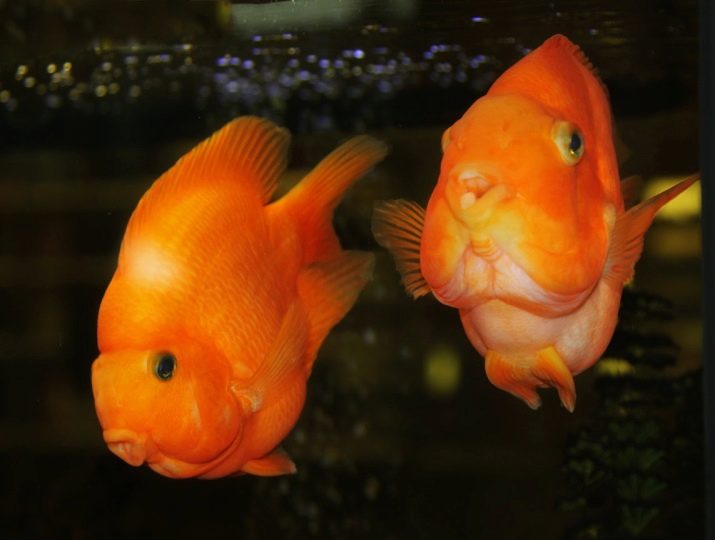
Like many genetically engineered species, spermatogenesis is completely absent in male parrotfish, rendering them sterile. However, they behave in the mating season in the same way as fertile species. Couples arrange mating games, dig up soil and prepare a place for spawn. Further, the females lay eggs, and this is where it all ends. Males are unable to fertilize eggs, which is why they die or are eaten by the male and the female.
If a couple lives in a common aquarium, and males of other cichlid species manage to fertilize eggs, then numerous offspring appear, similar in shape to the mother, but of a completely different color. For example, fry from red female to 5 months of age are gray-black in color, after which many of them turn orange.
They feed the fry 5 times a day with special feed, however, the parents themselves often bring prey to the house. They swim up to the offspring with a piece in their mouth and, after chewing, spit it out into the center of the flock.
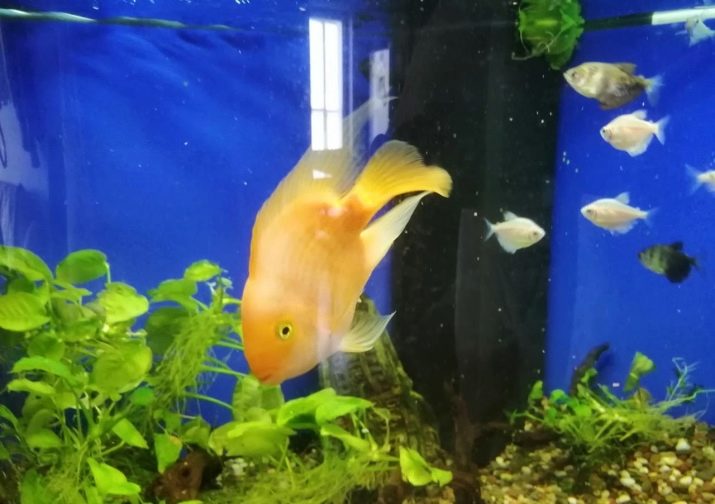
Interesting Facts
Parrotfish are a very interesting hybrid species of cichlids and do not leave anyone indifferent with their appearance and habits. So, at night, many of them are engaged in the formation of a cocoon of mucus, in which they safely spend the night. And also interesting is the fact that the color of parrots is unstable throughout their life, it changes depending on the age and conditions of detention. In this case, we mean natural unpainted varieties that have not been subjected to various executions.
The behavior of parrots in pairs is also interesting. After spawning and the appearance of fry, with the participation of another male, the "spouses" often sort things out and fight with each other. Whether this is due to the appearance in the house of "another man" or not is unknown, but the fact remains. Deserves attention and their the ability to remember the owner in person and in the future to recognize him unmistakably.
And one more interesting fact: in addition to parrot fish - representatives of the family of South American cichlids, there are several other species of aquarium fish with the same name.
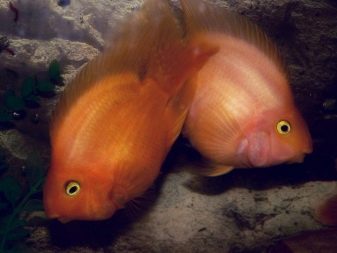
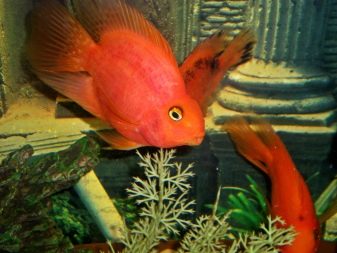
The smallest of them is pelvicachromis pulcher (lat.Pelvicachromis pulcher). This species already belongs to African cichlids, it differs from its overall congeners in its miniature size and absolute peacefulness. In addition, unlike large "parrots", the fish is of natural origin and is able to reproduce in a natural way. In the wild, the "parrot" is found in the rivers of Nigeria, Cameroon and other West African countries.
The length of miniature "parrots" rarely exceeds 8 cm, and the life expectancy is only 5 years. And the natural color in its decorativeness is much inferior to artificial dyes and tattoos characteristic of Asian hybrids, making the fish unobtrusive.
In addition to the miniature parrotfish, there are also large species such as green bumpy parrot fish. It belongs to the class of ray-finned wrasse order and, despite the same name, has nothing to do with the cichlid "parrots".
The coniferous "parrot" is a very large fish and, under good conditions and the presence of a spacious reservoir, grows up to 1 m. The giant fully corresponds to its name and has a characteristic growth on the forehead. Adults are very aggressive in nature and are suitable for keeping only in separate aquariums.
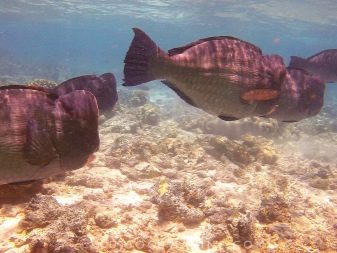
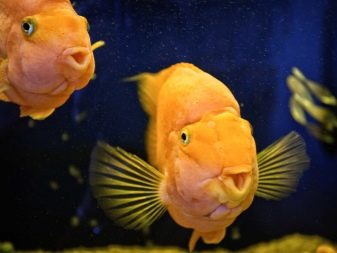
Find out more information about the parrotfish in the video below.








